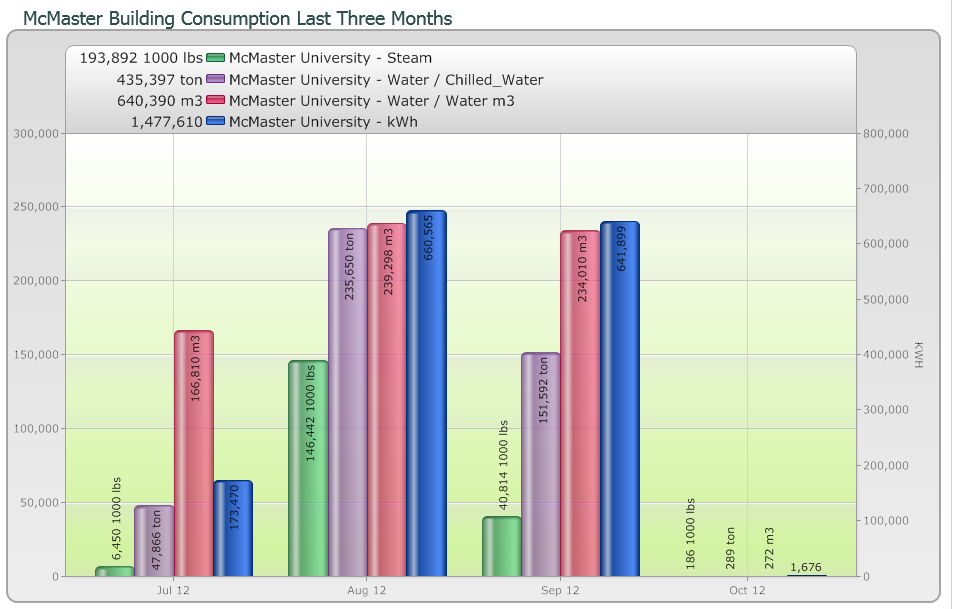Energy Management Business Intelligence Platform Development and Demonstration
Lead proponent: Power Measurement Ltd.
Location: Commercial buildings in Calgary, Alberta; Toronto, Ontario; and the BCIT Campus in Burnaby, British Columbia
CEF contribution: $ 3.6 M
Project total: $ 10 M
Project Background:
Energy demand is growing at a fast pace. In order for existing commercial and institutional buildings to operate nominally while reducing their impact on the grid and the environment, these buildings and their internal systems must operate more efficiently. To that end, Power Measurement Limited (PML) proposed the “Energy Management Business Intelligence Platform Development and Demonstration” project. The Project was awarded $3.6 M from the Clean Energy Fund to build on an existing energy management software, and expand into the areas of demand response for commercial and institutional buildings. The reliability and scalability of the software platform would also be improved.

Screen shot showing energy consumption at a building on McMaster University’s campus over 3 months (Jul, Aug and Sep)
Text version
Figure 1
Screen shot showing energy consumption at a building on McMaster University’s campus over 3 months (Jul, Aug and Sep):
193,892 1000 lbs of steam
435,397 ton of chilled water
640,390 m3 of water
1,477,610 kWh of electricity
PML is a wholly owned subsidiary of Schneider Electric and is located in Saanichton, B.C. The Project would see the development of a buildings edition of PML’s energy management software platform called “Power Measure Expert” or PME for buildings. Building energy management systems available on the market at the time of the Project were not able to provide building operators with the required data and information to give true insight into building operations.
Results:
The Project successfully demonstrated the capabilities of PME to provide insight into the energy consumption of commercial and institutional buildings based on interval data provided by intelligent electric meters installed in the buildings. PME was developed to allow, all levels of end-users from energy experts to accountants, a view into the energy consumption of the buildings operations. In order for energy consumption to be a broadly understood concept, a number of features and tools had to be introduced that converted archived interval meter data from a database and into actionable information. The information being sought could be as simple as current energy costs compared to a historical baseline, or as complicated as quantifying energy savings that result from the installation of a high efficiency HVAC system. Demonstration of PML’s new energy management software platform took place at three separate sites:
The first demonstration was conducted at Suncor Towers in Calgary, Alberta. Brookfield properties, the owners of the Suncor Towers (renamed to the Suncor Energy Centre), had the objective of achieving LEED® Canada EB:O&M certification. The PME was able to calculate rate of return for energy efficiency initiatives in the building, as well as inform the building tenants of their energy related greenhouse gas emissions.
A second demonstration was conducted at the Burnaby campus of the British Columbia Institute of Technology (BCIT). The campus had an assortment of buildings of various ages, constructed using a mix of technologies. PME was used in a variety of buildings to determine energy efficiency and identify sources of excessive energy consumption, as well as, incorporate onsite renewable energy generation.
A final demonstration was conducted at the main campus of McMaster University in Hamilton, Ontario. PME converted information about consumption into equivalent greenhouse gas emissions, and the results were used to inform students and staff at the campus about the current state of the emissions - all in an effort to quantify and reduce the campus’s carbon footprint.
Benefits to Canada:
Any reduction in the energy footprint of buildings through energy conservation, more efficient operations or use of renewable energy, will benefit all of Canada - building operations will become more sustainable.
Next Steps:
This software platform can be applied to other market segments besides commercial and industrial buildings. The current solution does not perform real time control however there are many real time systems that could be leveraged.
Page details
- Date modified: